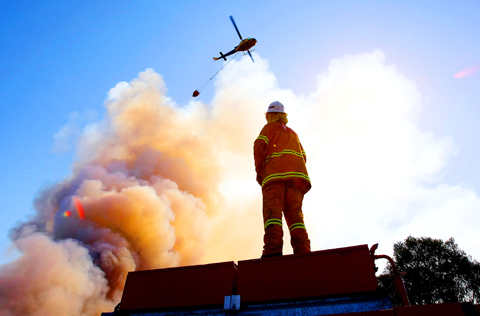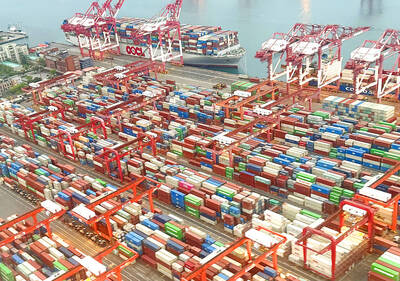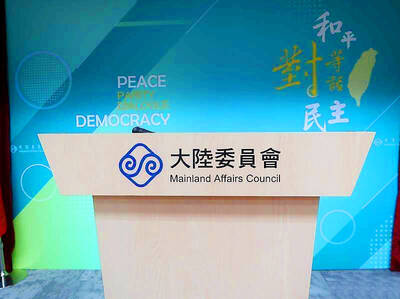At least 84 people were killed and entire towns razed in the worst wildfire disaster in Australian history, described by Australian Prime Minister Kevin Rudd as “hell in all its fury.”
People died in their cars as they attempted to escape the inferno — smoldering wrecks on roads outside this town told a tale of horror — while others were burned to death in their homes.
The toll looked set to rise further as medics treated badly burned survivors and emergency crews made it through to more than 700 houses destroyed by the fires, some of which have been blamed on arsonists.

PHOTO: AFP
Thousands of survivors jammed community halls, schools and other makeshift accommodation as troops and firefighters battled to control huge blazes fed by tinder-box conditions after a once-in-a-century heatwave.
“Hell in all its fury has visited the good people of Victoria in the last 24 hours. Many good people lie dead, many injured,” Rudd told reporters, deploying army units to help 3,000 firefighters battling the flames.
The number of dead rose steadily as rescue crews reached townships that bore the brunt of the most intense firestorm northwest of Melbourne, which survivors likened to a nuclear bomb.
The previous highest death toll in Australian wildfires was 75 people killed in Victoria and neighboring South Australia in 1983 on what became known as Ash Wednesday.
The latest fires in Australia’s southeast flared on Saturday, fanned by high winds after a heatwave sent temperatures soaring to 46˚C and continued to burn out of control yesterday.
They wiped out the pretty resort village of Marysville and largely destroyed the town of Kinglake north of Melbourne, with houses, shops, gas stations and schools razed to the ground.
Marie Jones said she was staying at a friend’s house in Kinglake, where at least 18 people perished, when a badly burned man arrived with his infant daughter saying his wife and other child had been killed.
“He was so badly burnt,” she told the Melbourne Age’s Web site.
“He had skin hanging off him everywhere and his little girl was burnt, but not as badly as her dad, and he just came down and he said ‘Look, I’ve lost my wife, I’ve lost my other kid, I just need you to save [my daughter].’”
A road was strewn with wrecked cars telling of desperate, failed attempts to escape.
The cars appeared to have crashed into each other or into trees as towering flames put an end to their desperate flight from the town.
Some did not even make it onto the road, said Victoria Harvey, a resident waiting at a roadblock to be allowed to return to the site of her destroyed home.
She told reporters of a local businessman who lost two of his children as the family tried to flee.
“He apparently went to put his kids in the car, put them in, turned around to go grab something from the house, then his car was on fire with his kids in it and they burnt,” she said.
In Kinglake scores of homes were leveled, some with just the roof lying flat on the ground where the house had stood.
The gasoline station and shops were also destroyed and the town was deserted except for police and forensic experts.
Police Deputy Commissioner Kieran Walshe said there was no doubt that arsonists were behind some of the fires.
“Some of these fires have started in localities that could only be by hand, it could not be natural causes,” he said.
Police have warned that arsonists could face murder charges.
The government’s Australian Institute of Criminology released a report last week which said half the country’s 20,000 to 30,000 bushfires each year are deliberate. At least 84 people were killed and entire towns razed in the worst wildfire disaster in Australian history, described by Australian Prime Minister Kevin Rudd as “hell in all its fury.”
People died in their cars as they attempted to escape the inferno — smoldering wrecks on roads outside this town told a tale of horror — while others were burned to death in their homes.
The toll looked set to rise further as medics treated badly burned survivors and emergency crews made it through to more than 700 houses destroyed by the fires, some of which have been blamed on arsonists.
Thousands of survivors jammed community halls, schools and other makeshift accommodation as troops and firefighters battled to control huge blazes fed by tinder-box conditions after a once-in-a-century heatwave.
“Hell in all its fury has visited the good people of Victoria in the last 24 hours. Many good people lie dead, many injured,” Rudd told reporters, deploying army units to help 3,000 firefighters battling the flames.
The number of dead rose steadily as rescue crews reached townships that bore the brunt of the most intense firestorm northwest of Melbourne, which survivors likened to a nuclear bomb.
The previous highest death toll in Australian wildfires was 75 people killed in Victoria and neighboring South Australia in 1983 on what became known as Ash Wednesday.
The latest fires in Australia’s southeast flared on Saturday, fanned by high winds after a heatwave sent temperatures soaring to 46˚C and continued to burn out of control yesterday.
They wiped out the pretty resort village of Marysville and largely destroyed the town of Kinglake north of Melbourne, with houses, shops, gas stations and schools razed to the ground.
Marie Jones said she was staying at a friend’s house in Kinglake, where at least 18 people perished, when a badly burned man arrived with his infant daughter saying his wife and other child had been killed.
“He was so badly burnt,” she told the Melbourne Age’s Web site.
“He had skin hanging off him everywhere and his little girl was burnt, but not as badly as her dad, and he just came down and he said ‘Look, I’ve lost my wife, I’ve lost my other kid, I just need you to save [my daughter].’”
A road was strewn with wrecked cars telling of desperate, failed attempts to escape.
The cars appeared to have crashed into each other or into trees as towering flames put an end to their desperate flight from the town.
Some did not even make it onto the road, said Victoria Harvey, a resident waiting at a roadblock to be allowed to return to the site of her destroyed home.
She told reporters of a local businessman who lost two of his children as the family tried to flee.
“He apparently went to put his kids in the car, put them in, turned around to go grab something from the house, then his car was on fire with his kids in it and they burnt,” she said.
In Kinglake scores of homes were leveled, some with just the roof lying flat on the ground where the house had stood.
The gasoline station and shops were also destroyed and the town was deserted except for police and forensic experts.
Police Deputy Commissioner Kieran Walshe said there was no doubt that arsonists were behind some of the fires.
“Some of these fires have started in localities that could only be by hand, it could not be natural causes,” he said.
Police have warned that arsonists could face murder charges.
The government’s Australian Institute of Criminology released a report last week which said half the country’s 20,000 to 30,000 bushfires each year are deliberate.
Also See: Boy feared taken by crocodile after floods in Australia

MORE VISITORS: The Tourism Administration said that it is seeing positive prospects in its efforts to expand the tourism market in North America and Europe Taiwan has been ranked as the cheapest place in the world to travel to this year, based on a list recommended by NerdWallet. The San Francisco-based personal finance company said that Taiwan topped the list of 16 nations it chose for budget travelers because US tourists do not need visas and travelers can easily have a good meal for less than US$10. A bus ride in Taipei costs just under US$0.50, while subway rides start at US$0.60, the firm said, adding that public transportation in Taiwan is easy to navigate. The firm also called Taiwan a “food lover’s paradise,” citing inexpensive breakfast stalls

TRADE: A mandatory declaration of origin for manufactured goods bound for the US is to take effect on May 7 to block China from exploiting Taiwan’s trade channels All products manufactured in Taiwan and exported to the US must include a signed declaration of origin starting on May 7, the Bureau of Foreign Trade announced yesterday. US President Donald Trump on April 2 imposed a 32 percent tariff on imports from Taiwan, but one week later announced a 90-day pause on its implementation. However, a universal 10 percent tariff was immediately applied to most imports from around the world. On April 12, the Trump administration further exempted computers, smartphones and semiconductors from the new tariffs. In response, President William Lai’s (賴清德) administration has introduced a series of countermeasures to support affected

CROSS-STRAIT: The vast majority of Taiwanese support maintaining the ‘status quo,’ while concern is rising about Beijing’s influence operations More than eight out of 10 Taiwanese reject Beijing’s “one country, two systems” framework for cross-strait relations, according to a survey released by the Mainland Affairs Council (MAC) on Thursday. The MAC’s latest quarterly survey found that 84.4 percent of respondents opposed Beijing’s “one country, two systems” formula for handling cross-strait relations — a figure consistent with past polling. Over the past three years, opposition to the framework has remained high, ranging from a low of 83.6 percent in April 2023 to a peak of 89.6 percent in April last year. In the most recent poll, 82.5 percent also rejected China’s

PLUGGING HOLES: The amendments would bring the legislation in line with systems found in other countries such as Japan and the US, Legislator Chen Kuan-ting said Democratic Progressive Party (DPP) Legislator Chen Kuan-ting (陳冠廷) has proposed amending national security legislation amid a spate of espionage cases. Potential gaps in security vetting procedures for personnel with access to sensitive information prompted him to propose the amendments, which would introduce changes to Article 14 of the Classified National Security Information Protection Act (國家機密保護法), Chen said yesterday. The proposal, which aims to enhance interagency vetting procedures and reduce the risk of classified information leaks, would establish a comprehensive security clearance system in Taiwan, he said. The amendment would require character and loyalty checks for civil servants and intelligence personnel prior to